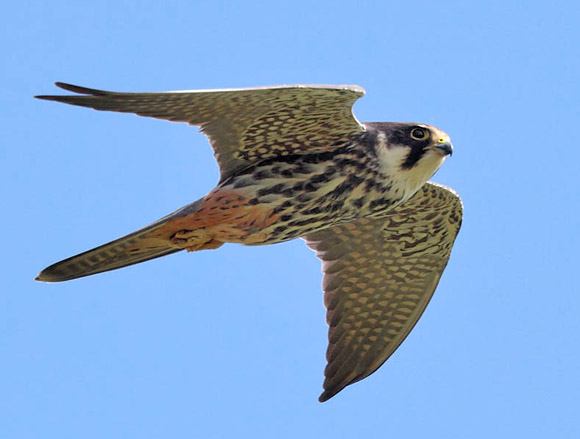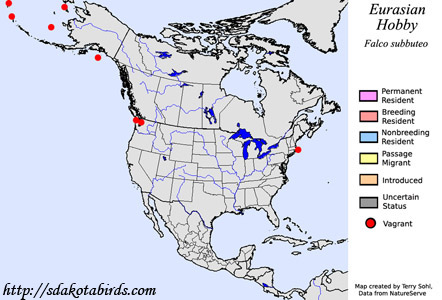| Length: 12 inches | Wingspan: 30 inches | Seasonality: Non-resident in South Dakota |
| ID Keys: Dark grey upperarts, white underparts with dark streaking, strong dark mustache, thin white eyebrow, ruddy leg feathering | ||
 The
Eurasian Hobby is a small graceful falcon of the Old World, with a summer
range stretching from Portgal eastward across Europe and Asia to Japan, and
a winter range in Africa and southeastern Asia. In North America, they
vagrants with widely scattered sightings. Most sightings have been in
Alaska, primarily the Aleutians and other offshore islands, but other
sightings have occurred in Washington State and Massachusetts. They
are aerial acrobats, specializing in capturing prey in flight. They will
often feed heavily on large insects which are both caught and consumed while
in flight, but they are also heavy predators on small birds. They are
extremely maneuverable and fast in flight, and are able to capture even
acrobatic birds in flight, such as swifts and swallows.
The
Eurasian Hobby is a small graceful falcon of the Old World, with a summer
range stretching from Portgal eastward across Europe and Asia to Japan, and
a winter range in Africa and southeastern Asia. In North America, they
vagrants with widely scattered sightings. Most sightings have been in
Alaska, primarily the Aleutians and other offshore islands, but other
sightings have occurred in Washington State and Massachusetts. They
are aerial acrobats, specializing in capturing prey in flight. They will
often feed heavily on large insects which are both caught and consumed while
in flight, but they are also heavy predators on small birds. They are
extremely maneuverable and fast in flight, and are able to capture even
acrobatic birds in flight, such as swifts and swallows.
Habitat: Found in a wide variety of semi-open habitats, including open woodland, savannah with scattered trees, farmland with scattered groves of trees and fencerows, and grassland with scattered trees. They are often found near rivers and wetlands.
Diet: Feeds heavily on flying insects when available. They will also often feed on small birds and rarely, on small rodents. In some locations, they have also been seen capturing bats in flight. Birds seem to make up the majority of prey during the breeding season.
Behavior: They are most active near dawn and dusk, and are often perched in cover during daylight hours.
Nesting: The nest site is typically an abandoned nest in a tree, with old corvid nests often used by the species. The female lays between 2 and 5 eggs, which are incubated (primarily by the female) for about 4 weeks. The young fledge at about 4 weeks of age.
Song: Has a piercing scream, kree-kree-kree-kree. They are usually silent away from nesting sites.
Migration: Most birds are strongly migratory. Eurasian Hobby breed throughout much of Europe and Asia, from western Europe eastward through Russian, China, and northern Japan. Most birds winter in Africa or southeastern Asia. Some birds in China and the surrounding area may be semi-permanent residents.
Interactive eBird map: Click here to access an interactive eBird map of Eurasian Hobby sightings
Similar Species: Similar in general markings and structure to a Peregrine Falcon, but that species is much larger.
Conservation Status: Populations have been in decline. Habitat loss has been a primary cause, but direct hunting, the use of harmful pesticides, and wind farm development have all also caused local and regional declines. However, overall populations are still strong and Eurasian Hobby are found over a very wide geographic region. The IUCN currently lists the Eurasian Hobby as a species of "Least Concern".
Further Information: 1) BirdLife International - Eurasian Hobby
2) European Raptors - Eurasian Hobby
3) WhatBird - Eurasian Hobby
Photo Information: Photo taken on April 21st, 2015 - Poiplie SPA, South Slovakia - Photo by Radovan Vaclav - Photo licensed under Creative Commons Attribution NonCommercial 2.0 Generic License
| Click below for a higher-resolution map |
 |
| South Dakota Status: Non-resident in South Dakota |
Additional Eurasian Hobby Photos (coming soon!!)
